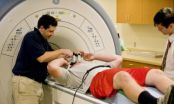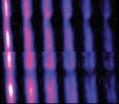(Press-News.org) CHAMPAIGN, Ill. — University of Illinois chemistry professor Alexander Scheeline wants to see high school students using their cell phones in class. Not for texting or surfing the Web, but as an analytical chemistry instrument.
Scheeline developed a method using a few basic, inexpensive supplies and a digital camera to build a spectrometer, an important basic chemistry instrument. Spectrophotometry is one of the most widely used means for identifying and quantifying materials in both physical and biological sciences.
"If we want to measure the amount of protein in meat, or water in grain, or iron in blood, it's done by spectrophotometry," Scheeline said.
Many schools have a very limited budget for instruments and supplies, making spectrometers cost-prohibitive for science classrooms. Even when a device is available, students fail to learn the analytical chemistry principles inherent in the instrument because most commercially available devices are enclosed boxes. Students simply insert samples and record the numbers the box outputs without learning the context or thinking critically about the process.
"Science is basically about using your senses to see things – it's just that we've got so much technology that now it's all hidden," Scheeline said.
"The student gets the impression that a measurement is something that goes on inside a box and it's completely inaccessible, not understandable – the purview of expert engineers," he said. "That's not what you want them to learn. In order to get across the idea, 'I can do it, and I can see it, and I can understand it,' they've go to build the instrument themselves. "
So Scheeline set out to build a basic spectrometer that was not only simple and inexpensive but also open so that students could see its workings and play with its components, encouraging critical-thinking and problem-solving skills. It wouldn't have to be the most sensitive or accurate instrument – in fact, he hoped that obvious shortcomings of the device would reinforce students' understanding of its workings.
"If you're trying to teach someone an instrument's limitations, it's a lot easier to teach them when they're blatant than when they're subtle. Everything goes wrong out in the open," he said.
In a spectrometer, white light shines through a sample solution. The solution absorbs certain wavelengths of light. A diffraction grating then spreads the light into its color spectrum like a prism. Analyzing that spectrum can tell chemists about the properties of the sample.
For a light source, Scheeline used a single light-emitting diode (LED) powered by a 3-volt battery, the kind used in key fobs to remotely unlock a car. Diffraction gratings and cuvettes, the small, clear repositories to hold sample solutions, are readily available from scientific supply companies for a few cents each. The entire setup cost less than $3. The limiting factor seemed to be in the light sensor, or photodetector, to capture the spectrum for analysis.
"All of a sudden this light bulb went off in my head: a photodetector that everybody already has! Almost everybody has a cell phone, and almost all phones have a camera," Scheeline said. "I realized, if you can get the picture into the computer, it's only software that keeps you from building a cheap spectrophotometer."
To remove that obstacle, he wrote a software program to analyze spectra captured in JPEG photo files and made it freely accessible online, along with its source code and instructions to students and teachers for assembling and using the cell-phone spectrometer. It can be accessed through the Analytical Sciences Digital Library.
Scheeline has used his cell-phone spectrometers in several classroom settings. His first classroom trial was with students in Hanoi, Vietnam, as part of a 2009 exchange teaching program Scheeline and several other U. of I. chemistry professors participated in. Although the students had no prior instrumentation experience, they greeted the cell-phone spectrometers with enthusiasm.
In the United States, Scheeline used cell-phone spectrometers in an Atlanta high school science program in the summers of 2009 and 2010. By the end of the 45-minute class, Scheeline was delighted to find students grasping chemistry concepts that seemed to elude students in similar programs using only textbooks. For example, one student inquired about the camera's sensitivity to light in the room and how that might affect its ability to read the spectrum.
"And I said, 'You've discovered a problem inherent in all spectrometers: stray light.' I have been struggling ever since I started teaching to get across to university students the concept of stray light and what a problem it is, and here was a high school kid who picked it right up because it was in front of her face!" Scheeline said.
Scheeline has also shared his low-cost instrument with those most likely to benefit: high school teachers. Teachers participating in the U. of I. EnLiST program, a two-week summer workshop for high school chemistry and physics teachers in Illinois, built and played with cell-phone spectrometers during the 2009 and 2010 sessions. Those teachers now bring their experience – and assembly instructions – to their classrooms.
Scheeline wrote a detailed account of the cell-phone spectrometer and its potential for chemistry education in an article published in the journal Applied Spectroscopy. He hopes that the free availability of the educational modules and software source code will inspire programmers to develop smart-phone applications so that the analyses can be performed in-phone, eliminating the need to transfer photo files to a computer and turning cell phones into invaluable classroom tools.
"The potential is here to make analytical chemistry a subject for the masses rather than something that is only done by specialists," Scheeline said. "There's no doubt that getting the cost of equipment down to the point where more people can afford them in the education system is a boon for everybody."
INFORMATION:
Editor's note: To contact Alexander Scheeline, call 217-333-2999; e-mail scheelin@illinois.edu.
Can you analyze me now? Cell phones bring spectroscopy to the classroom
2010-10-08
ELSE PRESS RELEASES FROM THIS DATE:
Technique allows researchers to examine how materials bond at the atomic level
2010-10-08
An approach pioneered by researchers at North Carolina State University gives scientists new insight into the way silicon bonds with other materials at the atomic level. This technique could lead to improved understanding of and control over bond formation at the atomic level, and opportunities for the creation of new devices and more efficient microchips.
Manufacturers build silicon-based devices from layers of different materials. Bonds – the chemical interaction between adjacent atoms – are what give materials their distinctive characteristics. "Essentially, a bond ...
Scientists trick bacteria with small molecules
2010-10-08
New Haven, Conn.—A team of Yale University scientists has engineered the cell wall of the Staphylococcus aureus bacteria, tricking it into incorporating foreign small molecules and embedding them within the cell wall.
The finding, described online in the journal ACS Chemical Biology this week, represents the first time scientists have engineered the cell wall of a pathogenic "Gram-positive" bacteria—organisms responsible not only for Staph infections but also pneumonia, strep throat and many others. The discovery could pave the way for new methods of combating the bacteria ...
Brain changes found in football players thought to be concussion-free
2010-10-08
WEST LAFAYETTE, Ind. - A study by researchers at Purdue University suggests that some high school football players suffer undiagnosed changes in brain function and continue playing even though they are impaired.
"Our key finding is a previously undiscovered category of cognitive impairment," said Thomas Talavage, an expert in functional neuroimaging who is an associate professor of biomedical engineering and electrical and computer engineering and co-director of the Purdue MRI Facility.
The findings represent a dilemma because they suggest athletes may suffer a form ...
Author who revealed unethical Guatemala syphilis study writes for Bioethics Forum
2010-10-08
(Garrison, NY) The researcher whose revelations about unethical U.S. studies on syphilis in Guatemala in the 1940's led to apologies from the Obama administration last week has written a commentary for Bioethics Forum, the Hastings Center's online publication. She calls for the need to learn from history to better protect human subjects in the developing world.
Susan M. Reverby, a professor at Wellesley College, describes how she unearthed documents about the study by accident while doing research for a book on the Tuskegee syphilis study. The documents, hidden in the ...
Notre Dame researcher helps discover 'walking' properties of bacteria
2010-10-08
Talk about a walk on the wild side: University of Notre Dame researcher Joshua Shrout is co-author of a new paper that shows that bacteria are capable of "standing up" and moving while vertical.
Shrout, assistant professor of civil engineering and geological sciences and a member of the Eck Institute for Global Health, has been studying the surface motility of bacteria since 2004. In 2008, UCLA researcher Gerard Wong suggested that an undergraduate bioengineering senior design group that he was advising track the bacterium Shrout was studying. After some interesting patterns ...
MRI zooms in on microscopic flow
2010-10-08
"Better and faster results!" is the clarion call for scientists and engineers to continually strive to improve their research tools. Of the tools used to study material structures at the atomic and molecular scales, there is none finer than Nuclear Magnetic Resonance (NMR) spectroscopy and its daughter technology Magnetic Resonance Imaging (MRI). Now, the latest development from the research group of one of the word's foremost authorities on NMR/MRI technology promises NMR/MRI results that are better and faster than ever before – a million times faster!
Through a combination ...
In Parkinson's disease, brain cells abandon mitochondria, researchers report
2010-10-08
In a study that sheds new light on the causes of Parkinson's disease, researchers report that brain cells in Parkinson's patients abandon their energy-producing machinery, the mitochondria. A shutdown in fuel can have devastating effects on brain cells, which consume roughly 20 percent of the body's energy despite making up only 2 percent of body weight.
The findings indicate that boosting the mitochondria with FDA approved drugs early on may prevent or delay the onset of Parkinson's. The study will be published in the one-year anniversary issue of the journal Science ...
Obese workers cost workplace more than insurance, absenteeism
2010-10-08
DURHAM, N.C. -- The cost of obesity among U.S. full-time employees is estimated to be $73.1 billion, according to a new study by a Duke University obesity researcher, published today in the Journal of Occupational and Environmental Medicine.
This is the first study to quantify the total value of lost job productivity as a result of health problems, which it finds is more costly than medical expenditures.
Led by Eric Finkelstein, deputy director for health services and systems research at Duke-National University of Singapore, the study quantified the per capita cost ...
Turtle, dugongs 'at risk under climate change'
2010-10-08
The "turtle and dugong capital of the world", the northern Great Barrier Reef (GBR) and Torres Strait region, faces increased pressure under climate change from human actions such as fishing, hunting, onshore development and pollution.
"Depletion of turtle and dugong numbers increases their vulnerability to other threats and lowers their ability to cope with climate change," Dr Mariana Fuentes of the ARC Centre of Excellence for Coral Reef Studies and James Cook University will tell the Coral Reef Symposium in Canberra today.
Dr Fuentes says that turtles in particular ...
New report: How will the affordable care act affect 15 million uninsured young adults?
2010-10-08
New York, NY, October 8, 2010—Young adults continue to represent one of the largest groups of Americans without health insurance, with nearly 15 million people aged 19-29 uninsured in 2009—an increase of more than 1 million over 2008, according to a Commonwealth Fund report released today. However, the Affordable Care Act (ACA) is poised to make a significant difference for this population, as up to 12.1 million could gain subsidized insurance once all of the law's provisions go into effect in 2014.
The report, Realizing Health Reform's Potential: Young Adults and the ...


